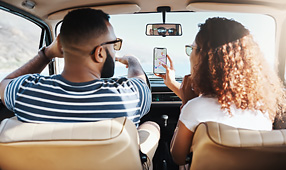Want to travel the world for free? It’s truly possible if you can master the miles and points game. To prove it, we called in three travel experts to share their insider secrets.
How to earn miles
There are many ways to earn miles, but the slowest way is to actually fly. To maximize your earning potential, consider trying these earning tactics:
Pay with credit.Stop paying with cash and instead use a rewards-earning credit card for every purchase you make, explains Summer Hull, author of Mommy Points and the Frequent Flyer Toolkits series, noting that this tactic only applies to those with good credit. If you use cash or debit, you are literally throwing free money away by missing out on the opportunity to earn lucrative rewards currency.
Maximize spend categories.“The key is to select a card that offers extra bonus rewards when you make purchases in certain categories.” For example, some cards offer five points per dollar spent at office supply stores, while others reward users with three points per dollar at grocery stores or two points per dollar at gas stations and restaurants. If you’re not sure which card to use, download the TPG To Go App—you simply link the cards in your wallet to the app and it will tell you which card will earn you the most points on a specific purchase. Aim to earn at least two points per dollar spent.
Sign-up bonuses.In addition to putting spend on credit cards, you can also earn miles from the sign-up bonuses new cards offer. Ben Schlappig, founder and author of One Mile At A Time, highlights the best offers every month (as do many frequent flier bloggers), and says it’s possible to pick up 500,000 miles per year through these bonuses.
Shopping and dining portals.Most airline, hotel and bank programs offer online portals that connect you with the stores you shop at regularly to help you earn more points, says Hull. “Simply visit the portal, log in to your loyalty account and click on the link to the store of your choice. You’ll then be rewarded bonus points just for taking that extra step to link via the portal.” Most portals earn an average of three to five more points per dollar, but some deals offer up to 60 points per dollar. Hull suggests checking Evreward, CashbackMonitor, and WebFlyer to see which portal will earn you the most bonus points. Similarly, many airlines also have dining programs where you link your credit card to their portal and automatically earn extra miles when dining at one of their restaurant partners, says Brian Kelly, founder of ThePointsGuy.com.
Loyalty or diversification?
“We’ve seen a lot of negative changes with airlines devaluing their programs, so as a general rule, I recommend diversifying your miles and points just like an investment portfolio,” says Kelly. However, be careful not to over-diversify, warns Schlappig, and instead try to keep points in a flexible points currency that can be transferred to a variety of airlines and hotels.
Hull agrees: “[You don’t want to] join every program under the sun and earn a few miles here and there that can’t be redeemed for anything. Focus on one or two programs that will help you attain a specific travel goal. Then, once you’ve learned the ropes of this hobby, branch out and earn in a wider range of programs that will be useful to you in the future.”
When to use miles vs. cash
“[Though it depends on what points you have,] the best value for your miles is nearly always going to be for international premium cabin travel, as those flights can be disproportionally expensive, and yet are pretty reasonable from a mileage perspective,” explains Schlappig. But with prices in constant flux, you’ll just have to do the math before booking. “Try to get at least one cent per mile,” says Kelly, noting that a $500 flight for 40,000 miles is a pretty good redemption. “That said, it all depends on your situation—if a redemption makes you happy and fits within your budget, then do it.” Hull seconds that notion: “Use your miles and points to fulfill your own travel dreams, [whether that means] saving enough miles to get the family to grandma’s a few states away in economy for Christmas, or focusing on a once-in-a-lifetime trip to Tahiti in first class.” Keep an “earn and burn” philosophy, though, rather than letting millions of miles accumulate and potentially expire or get devalued.
When to book with miles
It used to be that award space availability was released roughly 11 months out, but airline revenue management is more nuanced nowadays and award flight availability changes frequently. “You can start looking at that time, but know the seats you want could pop up a month or two later or even a few weeks before departure,” says Hull. So if you find a good redemption, book as far in advance as possible, or wait until the last possible minute, adds Schlappig. If you book and then a better award becomes available, you can often pay a fee to rebook that could save you thousands of miles, says Kelly.
New mileage earning rules
Some airlines, such as United, JetBlue, Southwest and Virgin America, reward travelers based on dollars spent rather than miles flown. “Essentially, this means that cheap tickets on long distance flights won’t earn you much, but short distances on expensive tickets will earn you more, so it’s all about doing the math,” says Kelly. “If you don’t fly often or usually purchase the lowest possible fare, focus on a program that rewards you for miles flown,” suggests Hull.












